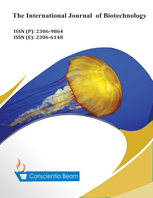Water Quality Assessment Using Benthic Macroinvertebrates in a Periurban Stream (Cameroon)
Abstract
In order to assess the water quality of Nga stream, the right tributary of Mefou, physicochemical variables were coupled to benthic macroinvertebrates communities. Physicochemical results revealed a good health status of the Nga stream, with significant differences of conductivity observed between stations and months (P < 0.05). Of the 2553 individuals collected (4 phyla, 7 classes, 15 orders, 74 families and 117 genera), Arthropods (99.25%) was dominated by the class of Hexapods (63.85%), followed by Decapods (35.41%), which were mainly predominated by Atyidae family (34.86%). Ephemeroptera-Plecoptera-Trichoptera (EPT) group (14.69%) constituted 25 families and 42 genera. EPT/Chironomidae density ratio varied significantly between stations and months (P < 0.05), while a significant correlation existed between temperature and dissolved oxygen (P < 0.05), temperature and pH, ammonia and nitrites (P < 0.05), Decapods and dissolved oxygen and Ephemeroptera and low degradable organic matter (P < 0.05). The Sorensen’s similarity coefficient expressed a close resemblance between stations Nga 1 and 3 (76.09%) and Nga 1 and 4 (77.69%). Shannon and Weaver and Pielou index revealed a diversified and equal distribution of macrozoobenthos downstream. The rank frequency diagram situated station Nga 1 at the growth phase and Nga 2, 3 and 4 at the maturation phase. The Hilsenhoff index (3.30 - 4.96) indicates good to excellent water status. The results of Nga stream could present referential characteristics used to follow up the evolution status of streams in non anthropisized zones of Cameroon.

